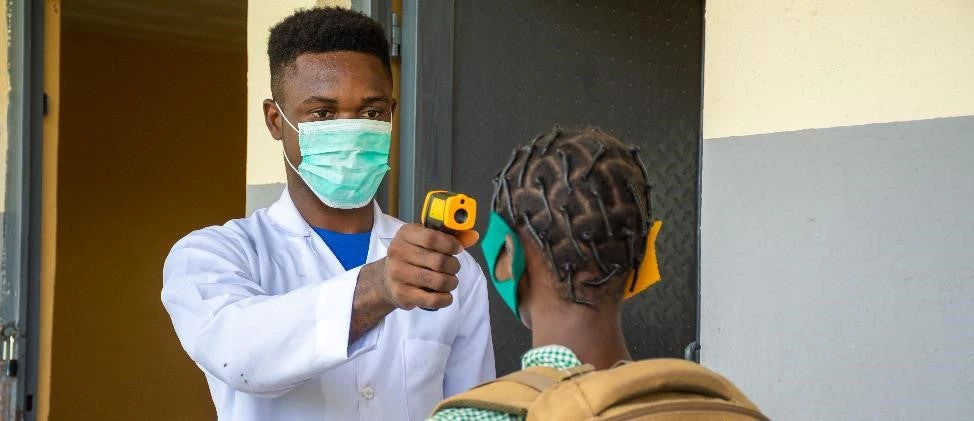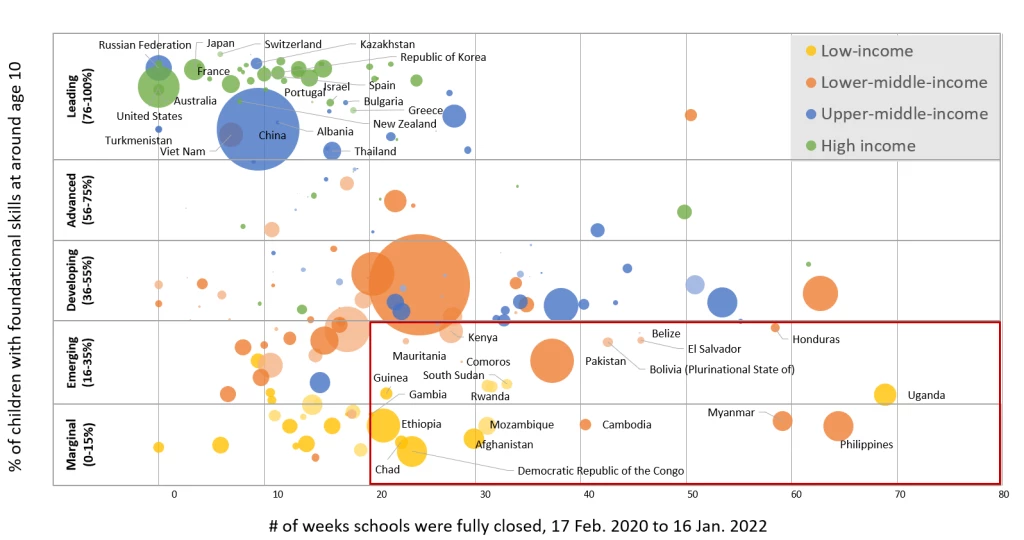 100 weeks of education disruption around the world. Photo credit: Shutterstock
100 weeks of education disruption around the world. Photo credit: Shutterstock
We are heading toward the 100th week of education disruption around the world. On average, each country has experienced 20 weeks of full school closures, plus another 20 weeks of partial closures. School children have lost an estimated 2 trillion hours – and counting – of in-person instruction since the onset of the COVID-19 pandemic and subsequent lockdowns.
In anticipation of the International Day of Education on January 24, UNESCO, UNICEF and the World Bank co-hosted the webinar Mission: Recovering Education - What is needed to avoid losing a generation [recording of the webinar in: Arabic; English; French; Spanish]. The event focused on the importance of keeping schools open and supporting learning recovery, as the highly contagious Omicron variant spreads around the globe, adding pressure on education officials to close schools once more.
The impact of school closures on learning has been devastating. Even before COVID-19, the world was grappling with a learning crisis. More than half of ten-year-olds in low-and middle-income countries were unable to read or understand a simple story. This figure could now reach 70 percent, due to lengthy school closures and a lack of effective remote learning opportunities. School closures tended to be longer in low- and middle-income countries and countries with lower pre-pandemic learning outcomes, exacerbating inequalities in education.
Figure 1. Countries grouped by length of school closures, learning outcomes and income level
Source: UNICEF calculation based on data from UNESCO Global Monitoring of School Closures, UNICEF MICS Foundational Learning Skills Module, and the World Bank Learning Poverty Index. The bubble size represents the relative population aged 10-14.
Real data confirms that students have incurred substantial learning losses during the pandemic, in countries from all income groups. The recent World Bank, UNICEF and UNESCO report The State of the Global Education Crisis: A Path to Recovery compiles studies on learning loss from 28 countries. The report shows that school closures affected girls, children from disadvantaged backgrounds, those living in rural areas, children with disabilities and children from ethnic minorities more than their peers. The youngest learners were often left behind in remote learning initiatives, as were children experiencing dire humanitarian crises prior to the pandemic.
The staggering effects of school closures reach beyond learning. This generation of children could lose a combined total of $17 trillion in lifetime earnings in present value – a sharp rise from the 2020 estimate of a $10 trillion loss. 24 million additional students may drop out of the school system. Children’s mental health is deteriorating, while risks of violence, child marriage and child labor are increasing. 10 million additional girls are at risk of child marriage over the next decade due to school closures.
Strategies to open schools and keep them open
The costs of closing schools outweigh the risks of keeping schools open. Evidence suggests that with strategies to minimize transmission in place, schools are not a driver of community transmission, nor are they high-risk environments for staff. Mitigation measures like improved ventilation, physical distancing and mask-wearing when appropriate can help reduce transmission in schools. In a forthcoming report based on a review of countries’ school sanitation protocols, UNESCO documents effective practices for keeping schools open. Recommendations include:
- Implementing safety protocols urgently needed to ensure schools remain open
- Simple and agile protection frameworks and traffic light systems reflecting transmission
- Clearly communicated plans that are continuously reassessed based on evidence
- Data-driven pandemic recovery agendas and learning recovery plans
- Defined strategies for teacher preparation, retention, motivation, well-being
Once schools are open, action is needed to get all children to return and re-engage with learning. This includes identifying barriers preventing children from returning to the classroom and finding ways to overcome them. Early warning systems to identify students at risk of dropping out, like the one developed in Chile, can help improve student retention.
Concrete actions to promote learning recovery
In the face of learning losses, it is critical that schools reopen and remain open with a commitment to delivering quality education for all. It is our duty to ensure that this cohort of students gets an education equivalent to that received by previous generations, despite lost time. We propose that every education system adopts a learning recovery program, comprised of a mix of evidence-based, contextually appropriate strategies.
The following levers constitute a menu of options to recover learning:
- Lever 1: Consolidating the curriculum across and within subjects to prioritize foundational skills and knowledge
- Lever 2: Increasing the efficiency of instruction to achieve more learning in the available time
- Lever 3: Expanding the time spent on instruction for a determined period of time
For curricular consolidation, the most important skills and content knowledge that a curriculum must cover are the pre-requisites for further learning, including foundational learning such as literacy, numeracy, and basic socioemotional competencies. If students have a weak grasp of conceptual pre-requisites, it can jeopardize future learning. How to implement curricular consolidation will be context dependent. In South Africa, the government is implementing a three-year curriculum recovery plan with emphasis on the fundamentals, to make up for lost instruction time during the pandemic. Two guiding principles should be to meet students where they are – so that at any time, they are studying material adjusted to their level – and to cover what they need to know to successfully enter the next grade.
To increase the efficiency of instruction, there are several policy options. First, supporting teacher capacity, which involves supporting teachers instructionally, technologically (with access to and training in technology), and supporting their resilience, by monitoring their wellbeing, providing opportunities for peer learning and fostering intrinsic motivation. Second, introducing new or reinforced instructional approaches. Below are examples of approaches which can be used at scale and have strong evidence of cost-effectiveness in a variety of contexts.
- Structured Pedagogy, a coherent set of materials and guidance that support teachers in delivering higher-quality instruction. Programs typically involve teacher professional development, lesson plans, and textbooks, and have been successful in Kenya.
- Targeted instruction, an approach that groups students by learning levels. It requires adjusting learning materials too; for a period, 4th grade students may need to use the 3rd grade textbook to catch up. The “Teaching at the Right Level” approach evolved by NGO Pratham has been rigorously studied at scale. In Uzbekistan, instruction tailored to students needs is breaking with the “one size fits all tradition” and in Gujarat, formative assessments and data analysis helped customize learning materials to students’ level.
- Small-group tutoring, which can be effective even when people delivering it are not homeroom teachers. Tutoring schemes are operating at scale in both the United Kingdom and Chile, helping students who have fallen behind catch up.
- Self-guided learning programs, which let students progress at their own pace, and can be delivered through paper and pencil, or via computer-assisted, often adaptive, programs. In India, personalized technology-aided after-school instruction led to improved student outcomes. In Afghanistan, physical self-study packages along with teacher-led tutorials distributed over radio, television, online, through CDs and flash drives were used to promote learning continuity for TVET students during lockdown.
The last lever involves expanding instructional time. The three main ways to expand instructional time includes modifying the school calendar by adjusting start/end days or shortening holidays, offering summer school, and extending the school day or week to cover more hours. Additional instructional time should be used wisely, ideally in tandem with pedagogies to improve the efficiency of instruction. As countries develop learning recovery programs, they must align changes across the curriculum, teaching and learning materials to ensure coherence.
The blog was produced as part of the Mission: Recovering Education 2021, through which the World Bank, UNESCO, and UNICEF are focused on three priorities: bringing all children back to schools, recovering learning losses, and preparing and supporting teachers.





Join the Conversation